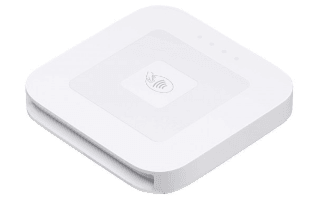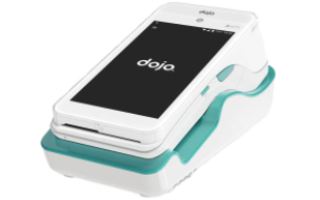Square is one of the most popular card reader providers, and Dojo’s products are very well reviewed: which one is best for your business?
Square vs Dojo: provider overview
Both providers offer one mobile card reader and one suitable for countertop use: here’s how their ranges compare.

| Products | Square Reader, Square Terminal |
|---|---|
| Payment methods | Contactless, Chip and Pin |
| Alternative payment methods | Payment link,Over the phone |
| Apple Pay | Yes |
| Google Pay | Yes |
| Connectivity | Bluetooth |
| Requires connection to a phone or tablet | Yes |
| Battery life | Designed to last all day |
| Warranty period | 24 months |

| Products | Dojo Go, Dojo One |
|---|---|
| Payment methods | Contactless, Chip and Pin, Magnetic swipe |
| Alternative payment methods | Payment link |
| Apple Pay | Yes |
| Google Pay | Yes |
| Connectivity | SIM card,WiFi |
| Requires connection to a phone or tablet | No |
| Battery life | 10 hours |
The Square Reader vs the Dojo Go: product overview
Let’s take a look at how these mobile-friendly card readers stack up against each other.

Square Reader

Dojo go
Compare rates and fees
One of the most important things to look at when you’re comparing card readers is the difference in the rates and fees each provider charges: not just the headline cost of each product, but the more ‘hidden’ fees too. For further explanations of the different charges you might come across in your research, use our handy guide.
The Square Reader and Dojo Go are both affordable options, but their pricing works quite differently.
For example, there’s no upfront cost for the Dojo Go, whereas the Square Reader is £19. However, this is because Dojo Go charges a monthly fee of £20 instead, so it will cost you more over time. On the other hand, the per-transaction cost is lower with Dojo Go, which charges 1.4% plus 3p, compared to Square’s 1.75%.
Compare features
Price isn’t the only consideration: you also need to think about what the card reader can actually do and whether it meets the needs of your business. For example, are you happy with a card reader that will need to be attached to a phone or tablet, like the Square Reader, or would you prefer something standalone like the Dojo Go?
For a full insight into the different features you should look out for when comparing card readers, you can use our helpful guide.
Bottom line
The Dojo card readers have some features that Square can’t offer, and the lower transaction cost means Dojo could work out cheaper per month than Square, depending on your turnover. However, with Dojo you are tied into a contract for a minimum of 6 months (or a monthly rolling contract if the annual card turnover is over £150k) so if you prefer the flexibility of a pay as you go card machine, you might prefer Square. Compare the full range to decide on the best choice for your business.
Compare the Square and Dojo range
More guides on Finder
-
Compare the best mobile card readers
Learn more about how a mobile card reader could benefit your business.
-
Compare the best portable card machines
Discover more about how portable card machines work and whether they are right for your business.
-
Compare virtual terminals 2025
If your business needs to take payments over the phone or by email, a virtual terminal could provide the perfect solution.
-
Card machine fees and charges
We take a closer look at the different fees you face when you get a card machine for your business.
-
Compare myPOS card readers
Learn more about how myPOS card readers work.
-
Compare Stripe card readers
We compare Stripe’s full card reader range.
-
Compare Dojo card readers
Shorter contracts and affordable fees, start comparing Dojo Card readers for your business.
-
Compare takepayments card readers
Learn more about takepayments card readers to see if they are a good fit for your business
-
Compare SumUp card readers
In need of a card reader for your business and not sure where to start? Check out our review on the SumUp card machines.
-
Compare Square card readers
Find out how Square card readers work to see if they are right for you and your business.
